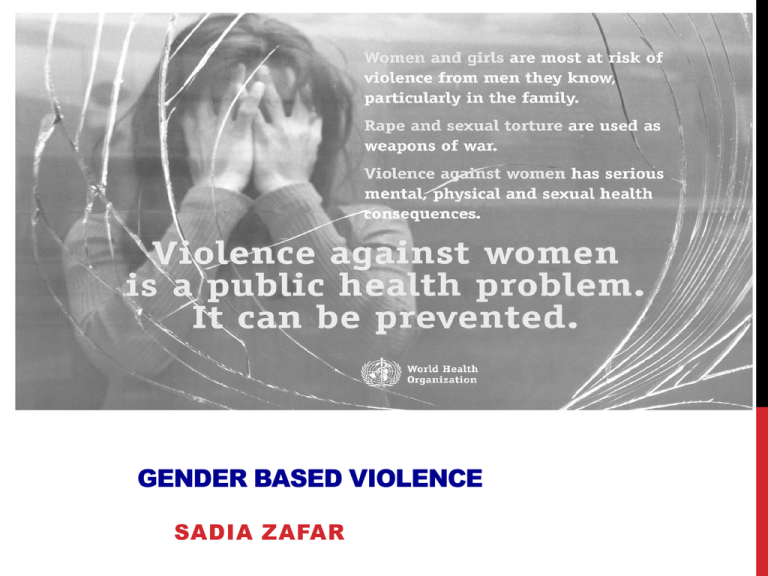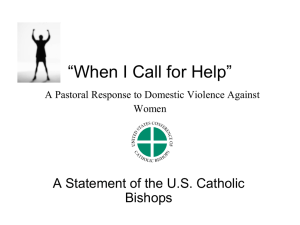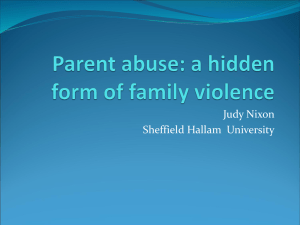
GENDER BASED VIOLENCE
SADIA ZAFAR
DEFINITIONS
United Nations
Gender-based violence which involves acts or
threats of physical, sexual or psychological
harm/suffering
• Health Canada has adopted the same definition
Violence can occur within
• Family
• Community
2
• State
VIOLENCE IN COMMUNITY
Community: Physical, sexual and psychological
violence that occurs within the general community
• Rape
• Sexual harassment
• intimidation at work
• Trafficking
3
• forced prostitution
VIOLENCE IN STATE
Physical, sexual and psychological violence
perpetrated or condoned by the State, wherever it
occurs.
• Discriminatory laws
• Violence in state custody
4
• Rape and sexual torture as weapons of war
VIOLENCE WITHIN FAMILY
• Battering.
• Sexual violence including marital rape.
• Dowry-related violence.
• Female infanticide.
• Sexual abuse of female children in the household.
• Female genital mutilation.
• Early marriage/Forced marriage.
5
• Non-spousal violence/Violence perpetrated against
domestic workers.
INTIMATE PARTNER VIOLENCE
(IPV)
• Any physical, sexual, psychological, or financial
abuse attempted by one’s current or former intimate
partner.
• 1 in 3 women experiences intimate partner violence
during her life (United Nations, 2006).
6
• 25% of all Canadian women experience violence by
their marital partners (Health Canada, 1993).
INTIMATE PARTNER VIOLENCE
(IPV)
•
7 % of women reported being physically or sexually
victimized by their spouse in the last 5 years
• About 17% Canadians reported experiencing
emotional or financial abuse from intimate partners
• Intimate partner violence, including both spousal
and dating violence, accounts for one in every four
violent crimes reported to police.
7
(2009 General Social Survey)
IPV
• 35% of female college and university students
reported that they had been physically abused (Health
Canada, 1999).
• Majority of studies note that 1 in 3 college women
are physically abused by a male partner (Anderson &
Danis, 2007).
• Many male university students, indirectly and/or
directly, support their peer’s abusive conduct
(DeKesserdy & Schwartz, 2000).
8
GENDER IN IPV
• Distinct victimization experiences for men and
women (Johnson & Dawson,2011)
• Frequency and severity greater for female victims
(AuCoin 2005; Tjaden &Thoennes 2000).
• In 2009, 46,918 spousal violence incidents reported
in Canada, 81.2% of these incidents were
committed against women
• Women continue to outnumber men nine to one as
victims of assault by a spouse or partner (Health
9
Canada)
PREDICTORS OF IPV
• Young age of the couple (18-24 years)
• Chronic unemployment of male partner
• Men and women who witness abuse as a child
• Presence of emotional abuse in relationship
10
(Statistics Canada, 1998)
Types of Abuse
• Physical abuse
• Sexual abuse
• Psychological abuse
• Emotional abuse
11
• Economic abuse
THEORETICAL APPROACHES
O’Neil (1998) categorizes theories of IPV in five
discourses as follows.
•Pathology
•Learned behavior
•Normative social system
•Expressive violence
12
•Instrumental power
FEMINIST SOCIOPOLITICAL
APPROACH
• IPV is a controlling behaviour.
• IPV creates and maintains male dominance and
imbalance of power between partners.
• Wife abuse is an instrumental power strategy
approved by the socio-cultural context of patriarchal
institutions.
Types of Patriarchy:
13
Structure
Ideological
PATRIARCHY
The United Nations Secretary General’s report (2006)
“All forms of violence against women” notes:
•Violence is used to maintain the hierarchical gender
roles fashioned by patriarchy
14
•Systemic gender inequality and women’s
subordination are institutionalized by patriarchal
ideology.
15
MYTHS ABOUT IPV (1)
Myth 1: Abuse is not a widespread problem
20% of all homicides in Canada are domestic
25% of women attempting suicide are abused
Myth 2: An abusive act is usually a one time event
Multiple episodes before disclosure
Myth 3: Injuries resulting from abuse are not serious
16
Health costs estimated to be 1.5 billion (Health Canada)
MYTHS ABOUT IPV (2)
Myth 4: Abuse happens in only certain communities.
IPV transcends the boundaries of nation, culture, race,
class, and religion.
Myth 5: Some women like being abused.
No one likes being abused.
Myth 6: Men who abuse are mentally ill/ are alcoholics.
Too widespread to be attributed to mental illness.
Myth 7: It is easy for a woman to leave the abuser.
17
Discuss it a little later
PSYCHOLOGICAL CONSEQUENCES OF
VIOLENCE (1)
Problems
•
Fear, hypervigilance, low self-esteem, self-blame, safety
issues, difficulty sleeping,uncomfortable with sexuality,
body image, and nightmares.
Psychiatric Illnesses
Anxiety disorders, eating disorders, depression,
substance abuse, suicide attempts, and self-harm, 74%
more likely to use sedatives and 40% more likely to take
sleeping pills than women not assaulted. (ARF;Groeneveld &
Shane, 1989)
18
•
PSYCHOLOGICAL CONSEQUENCES OF
VIOLENCE (2)
Meta-analysis (Golding ,1999) suggests following
prevalence rates among female IPV victims.
• 48% for depression
• 64% for PTSD
• 18% for suicide
19
suicide 12 times more likely to have been attempted by
a woman who had been abused by a spouse than by a
woman who had not been abused (United Nations 1989)
PSYCHOLOGICAL CONSEQUENCES FOR
CHILDREN (1)
social disorders (hyperactivity & aggressiveness)
emotional disorders (mental health issues)
delinquency issues (Dauvergne & Johnson 2001)
The Adverse Childhood Experiences Study(1998)
o Childhood exposure to spousal violence adverse
health, social, and economic effects
20
•
•
•
•
PHYSICAL CONSEQUENCES OF
VIOLENCE
• Bleeding and/or bleeding or internal organs
• Bruising: pattern bruises, symmetrical bruises,
bruises in varying stages of healing
• Injuries to face & head, dental damage
• Perforated eardrums
• Broken bones
21
• Burns (stoves, appliances, acids)
COST OF ABUSE
• Justice Canada: Spousal violence in Canada costs
over $7.4 billion in 2009
• Major proportion: intangible costs, pain and suffering
for victim and family members
22
• Tangible costs: Health care, Criminal justice system,
Social services , lost income
23
SPOUSAL VIOLENCE ATTRITION
PYRAMID
WHY LACK OF REPORTING ?
• Incident had been dealt with another way (58%)
• “Personal matter" (49%)
• Didn't want to involve the police (45%)
• considered the incident to be minor (38%)
• felt the police couldn't do anything about it (33%)
•
feared revenge from the perpetrator (24%)
24
(VAWS, 1993).
RESPONDING TO ABUSE
• Therapy
• Leave the Relationship
25
• Go to a shelter
THERAPY (1)
Abuser
•Feminist psychoeducational model
•Cognitive-behavioral group model
Marital/Couple
•Only helpful when the relationship between the
partners alternates as perpetrator and victim
26
•In cases of classic “intimate partner violence,” marital
therapy will not work
LEAVING THE RELATIONSHIP
• Does not stop the abuse.
• Harass, stalk, and harm the woman even resulting
in femicide (Browne, 1987; Walker, 1989; Walker & Meloy,1998).
• 70% of the reported injuries from domestic violence
occurred after the separation of the couple (Liss & Stahly,
27
1993).
BARRIERS TO LEAVING (1)
• Economic necessity
• Isolation from friends, family, community support,
resources
• Fear of retaliation; of being alone
• Threats: will commit suicide
• hurt their partner/children, other loved ones and/or pets,
take the children away
28
• Lack or resources or information about available
resources
BARRIERS TO LEAVING (2)
• Love and concern for partner’s well-being Lo
• Hope/belief that partner will changep
• Culture/ religion/ family pressure
• Shame and guilt
Depression
29
•
BARRIERS TO LEAVING (3)
• Belief that the abuse is their fault fault.
• Immigration: fear of deportation without partner’s
support, fear of separation from children, law
enforcement
30
• Children; desire to provide them with a two-parent
home, custody concerns
SHELTERS (1)
• Provide for basic living needs, including food and
childcare for mother and children
• Limited time stay
31
• Helps to start a new life
SHELTERS (2)
Connect to various services and resources such as
•
Legal help
• Counseling
• Support groups
• Services for children
• Employment programs
• Health-related services
• Educational opportunities
32
• Financial assistance
CONCLUSION
33
• Leaving only a first step.
• Many factors determine if a woman and her children
can make a new life or will return to the abusive
relationship.
• Emotional and practical support appears to have the
greatest effect on psychological and physical wellbeing.
• Need still is far greater than available services.










